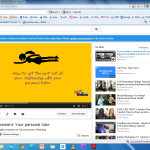
GRASS Lunch and Learn – Friday 28 November
Many thanks to those who attended the first GRASS informative session last Friday. We had an excellent turnout of 33 colleagues and some very positive feedback. Our thanks go also to Gavin Brookes, who took time out of his day to attend and introduce the session.
Of the 22 questionnaires returned, 15 rated the session as ‘excellent’ and 6 rated it ‘good’. 18 are likely to use screen capture and the GRASS website. There was even great praise for our cakes! This is very encouraging news!
A number of you flagged up either the lack of time or IT support. Like with everything, practice is the key and it is amazing how quickly you can learn how to use the software packages and the screen capture platform. It really is VERY intuitive! With regard to lack of IT support, we have set up the GRASS project in order to help you with any problems you come up against, and are happy to give email or one-to-one advice in your own office if necessary. Just contact me (susie.newton@reading.ac.uk) and I can talk you through problems or arrange a call out.
We have also two high spec laptops already loaded with the Camtasia Studio software, together with some excellent quality microphones and we are happy to lend these out.
A number of you seem confused by the range of applications/software, and which did what, so here is a summary:
Screencapture software
Camtasia Studio – (www.techsmith.com/camtasia.html) screencapture platform – simply it records the screen and produces it to be uploaded to an MP4, YouTube, or Screencast.com (this gives your screencast a www address which is useful for embedding in webpages or emailing to others). You can have a free Camtasia Studio 30 day trial (they are happy to extend this if necessary) and the licence is low cost.
Jing- (www.techsmith.com/jing.html) screencapture free platform – records the screen and is free but quality is not as good as Camtasia. The disadvantage also is that your recordings are limited to 5 minutes.
There are many other forms of free screencast software such as Screen o matic (www.screencast-o-matic.com/), Snagit (http://www.techsmith.com/snagit.html). Free software however usually have limitations and are designed to encourage upgrading to paid alternatives. For Apple Mac, Tapes (https://v.usetapes.com/r/9SPtpdTLaKOkMSCukCkh) has extremely good reviews and is good value for money.
For a non-bias, educational viewpoint from an expert who has tried all screencapture software see : https://andrewdouch.wordpress.com/2014/02/13/the-best-screencasting-software-for-teachers/
Presentation software
Prezi – (www.prezi.com) free presentation software – a vast number of thematic and colourful templates that can be used to produce presentations. The software zooms in on different areas of the  screen and can include Youtube or other screencapture clips. Prezi comes with a huge number of free templates. The websites Prezi Base and Prezi Zip offer even more choice. Most templates on these sights cost around $10 but they can be used again and again.
screen and can include Youtube or other screencapture clips. Prezi comes with a huge number of free templates. The websites Prezi Base and Prezi Zip offer even more choice. Most templates on these sights cost around $10 but they can be used again and again.
Powtoons – (www.powtoons.com) free cartoon type software using quirky presentation tools and music, as well as “read as you write” text. Students like this medium but it can also be used for more formal presentations too
Video Scribe – (www.videoscribe.co/) free 7 day trial
Our next group session will be Friday 27 March from 1-3pm in Carrington 101 – you can either, come along and build upon your experience, ask any questions or feedback any problems…… or if you have not been motivated enough by either the last session or time constraints, have a recap and a try!
















